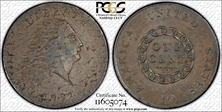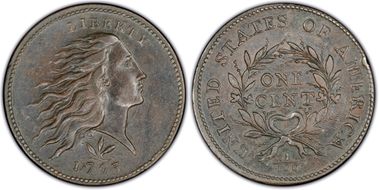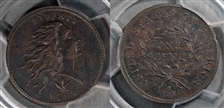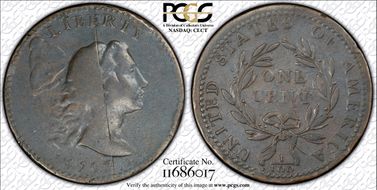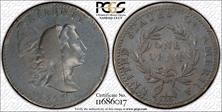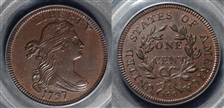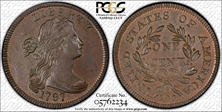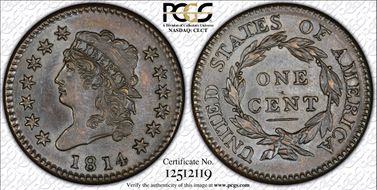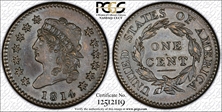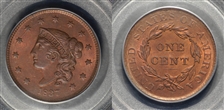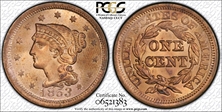Golbrecht's Raisinet Collection 的钱币相册
1793 Chain 1C AMERICA AU53. S-3, B-4, Low R.3. EAC 40. Surfaces: The obverse surface has countless minute defects that appear to be almost entirely planchet flaws, representing an improperly refined strip of copper, a common problem in the first year of Mint operations. Sheet copper was not yet available from England, so available copper was scrap copper from local sources that Henry Voigt acquired. In his Encyclopedia of Large Cents, Breen discussed the problems with this locally available copper: "Scrap copper varied greatly in homogeneity, density, malleability, and hardness. This is partly from different trace elements and partly from the way the individual lumps had been treated in manufacture. This was a most unsatisfactory expedient; the coiner's department learned quickly that different ingots cast from it varied greatly , with far too many gas bubbles. Strip rolled from these ingots came out with too many cavities and laminations. Many surviving Chain cents accordingly show such flaws." The sophisticated collector will appreciate the planchet flaws as part of this coin's history and charm. A few tiny rim bumps are visible, and these appear to be the only post-strike imperfections. In direct opposition to the obverse, the reverse surface is nearly flawless. Only a few minute defects, rim flaws, and abrasions can be seen. Both sides have lovely medium brown color with traces of darker steel color on the high points. Considerable original mint frost remains, with splashes of lighter tan on the reverse, faded from original mint red. This example is a later die state. The obverse has prominent clash marks around and below the bust, and the reverse is flowlined with field roughening below UNITED STATES. The latest known die state of this variety, called Die State III in Breen's classification, displays heavy clash marks along Liberty's lips, chin, neck, and bust line. Breen suggested that these obverse clash marks, as seen somewhat on this example, were responsible for the "Liberty in chains epithet" sometimes given to the Chain cents. The Chain design was intended to show strength or unity of our new nation. Instead, the device was interpreted by many as representing slavery. Most of the mintage was lost or destroyed, so survivors are of various grades, usually lower quality. Porous or corroded pieces are frequently encountered. There is no question among specialists that Sheldon-3 is the most common Chain cent. Current rarity ratings for the Chain cent varieties suggest that the total surviving population of all varieties is 900 to 1,000 coins, with 400 to 500 examples of the S-3 and about 500 to 600 of all other varieties combined. Working under the assumption that the current rarity ratings are reasonably accurate, we can surmise that the original mintage occurred in about the same proportion. Approximately 18,000 examples of this die marriage were coined, with another 18,000 of the other three Sheldon numbers.
S-9, B-12, R.2. Noyes VF20; tied for CC-21. EAC VF25. PQ–. Variety: Horizontal stem parallel to the date. The bow is large and rounded. The obverse appears on S-8, S-9, and NC-4. The reverse appears on S-9. Vine and Bars Edge. The S-9 is the single most common Wreath cent variety by a wide margin. Surfaces: An attractive piece with smooth, hard, glossy surfaces. Both sides have mottled golden-brown and deep steel color. A few minor handling marks are visible on the obverse, with a small reverse edge bump over the M. Light corrosion is evident, primarily on the reverse. Full obverse and reverse borders are visible, with the reverse imperfectly centered. Both sides are sharply detailed, and the obverse and reverse types stand boldly against the field. Die State VII: The reverse has die cracks through R and CA of AMERICA, and from the left stem through UNIT. A late die state, although most of the individual die defects Breen describes are faintly visible. Census: Perhaps 10 examples are known in Mint State. This piece has considerable sharpness but is downgraded for various minor imperfections. Commentary: The S-9 is clearly the most common Wreath cent variety, and the only 1793 large cent of any design with a rarity rating less than R.3. Sheldon mentioned in Early American Cents that S.H. Chapman considered this variety to represent 35% of all existing Wreath cents. From a mintage of 63,353 Wreath cents, this would imply a "mintage" of about 22,000 coins. Raw material for copper coinage at the new Mint came from a variety of local sources, none particularly ideal, generally consisting of scrap, rough ingots, or sheet. In Breen's Large Cent Encyclopedia, contributor Craig Sholley wrote: "The locally obtained scrap proved to be especially troublesome. Copper is a difficult metal to properly melt and it is far more difficult to roll than silver or gold. The Mint, lacking both experience and proper equipment, was not prepared for either of these operations." The first of the two processes required that Mint personnel melt the metal and pour it into ingot molds, while watching for retained gas bubbles or impurities. Bubbles in the metal resulted in split planchets, laminations, or other defects to the finished coins. Impurities resulted in various streaks or discoloration spots. The other process was rolling the ingots into planchet strip of the appropriate width and thickness. The Mint used horsepower-operated rollers that were apparently poorly made. Coinage of the Wreath cents was suspended after the April 19 delivery while the rollers were repaired.
S-9, B-12, R.2. Noyes VF20; tied for CC-21. EAC VF25. PQ–. Variety: Horizontal stem parallel to the date. The bow is large and rounded. The obverse appears on S-8, S-9, and NC-4. The reverse appears on S-9. Vine and Bars Edge. The S-9 is the single most common Wreath cent variety by a wide margin. Surfaces: An attractive piece with smooth, hard, glossy surfaces. Both sides have mottled golden-brown and deep steel color. A few minor handling marks are visible on the obverse, with a small reverse edge bump over the M. Light corrosion is evident, primarily on the reverse. Full obverse and reverse borders are visible, with the reverse imperfectly centered. Both sides are sharply detailed, and the obverse and reverse types stand boldly against the field. Die State VII: The reverse has die cracks through R and CA of AMERICA, and from the left stem through UNIT. A late die state, although most of the individual die defects Breen describes are faintly visible. Census: Perhaps 10 examples are known in Mint State. This piece has considerable sharpness but is downgraded for various minor imperfections. Commentary: The S-9 is clearly the most common Wreath cent variety, and the only 1793 large cent of any design with a rarity rating less than R.3. Sheldon mentioned in Early American Cents that S.H. Chapman considered this variety to represent 35% of all existing Wreath cents. From a mintage of 63,353 Wreath cents, this would imply a "mintage" of about 22,000 coins. Raw material for copper coinage at the new Mint came from a variety of local sources, none particularly ideal, generally consisting of scrap, rough ingots, or sheet. In Breen's Large Cent Encyclopedia, contributor Craig Sholley wrote: "The locally obtained scrap proved to be especially troublesome. Copper is a difficult metal to properly melt and it is far more difficult to roll than silver or gold. The Mint, lacking both experience and proper equipment, was not prepared for either of these operations." The first of the two processes required that Mint personnel melt the metal and pour it into ingot molds, while watching for retained gas bubbles or impurities. Bubbles in the metal resulted in split planchets, laminations, or other defects to the finished coins. Impurities resulted in various streaks or discoloration spots. The other process was rolling the ingots into planchet strip of the appropriate width and thickness. The Mint used horsepower-operated rollers that were apparently poorly made. Coinage of the Wreath cents was suspended after the April 19 delivery while the rollers were repaired.
S-14 Low R.5, EAC 20. While the Chain and Wreath Cents boast the cachet of single year type status, it is the Liberty Cap design that is the scarcest for the year. Walter Breen estimated that only 250 Liberty Cap cents dated 1793 exist in all grades and of all varieties. The Sheldon-14 is an unmistakable, “naked eye” variety which can be identified at arms length by the spectacular, rim-to-rim die crack down the middle of the obverse. This is the famous Bisecting Crack variety, with a constant and readily visible (usually) vertical die crack on the obverse, from the E of LIBERTY to the 3 in the date. The crack passes through Liberty's earlobe, and almost perfectly divides the obverse in half, slightly favoring the right side. The elusiveness of this particular variety can, in large measure, be attributed to the obvious broken die, from which relatively few coins could have been struck before it finally had to be replaced. With a surviving population of about 70 pieces, the Bisecting Crack is the second most common variety of the six 1793 Liberty Caps, although it is substantially rarer than Sheldon-13. The rarity of this variety has remained essentially unchanged since 1949, when Sheldon gave it an R.5 rating. Perhaps the stable rarity rating is due to the recognizable nature of the obverse. A completed coinage die was not ready for use until it was hardened. The February 1826 issue of The Franklin Journal described the hardening process, quoted in Breen's Large Cent Encyclopedia: "The general method of hardening this metal is to heat it red hot, and then plunge it into cold water, and sometimes into mercury, in order to reduce its temperature as quickly as possible." Craig Sholley notes that the hardening process was the "moment of truth" once a die was engraved. Many dies cracked or shattered during the process. Others only hardened near the edges, and cracked or broke upon first use. It was the results of this procedure, according to Sholley, that have often been described as "poor die steel." There is little doubt that the hardening process resulted in the Bisecting Crack variety.
S-14 Low R.5, EAC 20. While the Chain and Wreath Cents boast the cachet of single year type status, it is the Liberty Cap design that is the scarcest for the year. Walter Breen estimated that only 250 Liberty Cap cents dated 1793 exist in all grades and of all varieties. The Sheldon-14 is an unmistakable, “naked eye” variety which can be identified at arms length by the spectacular, rim-to-rim die crack down the middle of the obverse. This is the famous Bisecting Crack variety, with a constant and readily visible (usually) vertical die crack on the obverse, from the E of LIBERTY to the 3 in the date. The crack passes through Liberty's earlobe, and almost perfectly divides the obverse in half, slightly favoring the right side. The elusiveness of this particular variety can, in large measure, be attributed to the obvious broken die, from which relatively few coins could have been struck before it finally had to be replaced. With a surviving population of about 70 pieces, the Bisecting Crack is the second most common variety of the six 1793 Liberty Caps, although it is substantially rarer than Sheldon-13. The rarity of this variety has remained essentially unchanged since 1949, when Sheldon gave it an R.5 rating. Perhaps the stable rarity rating is due to the recognizable nature of the obverse. A completed coinage die was not ready for use until it was hardened. The February 1826 issue of The Franklin Journal described the hardening process, quoted in Breen's Large Cent Encyclopedia: "The general method of hardening this metal is to heat it red hot, and then plunge it into cold water, and sometimes into mercury, in order to reduce its temperature as quickly as possible." Craig Sholley notes that the hardening process was the "moment of truth" once a die was engraved. Many dies cracked or shattered during the process. Others only hardened near the edges, and cracked or broke upon first use. It was the results of this procedure, according to Sholley, that have often been described as "poor die steel." There is little doubt that the hardening process resulted in the Bisecting Crack variety.
1795 1C Plain Edge AU58 S-78, B-8, R.1. This is one of the most common of all Liberty Cap large cent varieties and an ideal candidate for the date or type collector. For this die pairing, the peak of the 5 in the date just touches the bust truncation. Date and LIBERTY are closely spaced. ONE CENT is centered in the wreath and widely separated. ONE CENT is high in the wreath, as the engraver avoided placing CENT within the narrow space between the lower leaves, and the E in STATES is entered high. Specialists of 1795 cents know that the two most common varieties are S-76b and S-78, both Plain Edge varieties. The Lettered Edge varieties are significantly scarcer, as indicated by Guide Book prices. While none of the three collectible Plain Edge 1795 cent die pairs can be considered more than scarce, the type is more in-demand than the supply can handle, especially for better conditions such as Choice AU.
1795 1C Plain Edge AU58 S-78, B-8, R.1. This is one of the most common of all Liberty Cap large cent varieties and an ideal candidate for the date or type collector. For this die pairing, the peak of the 5 in the date just touches the bust truncation. Date and LIBERTY are closely spaced. ONE CENT is centered in the wreath and widely separated. ONE CENT is high in the wreath, as the engraver avoided placing CENT within the narrow space between the lower leaves, and the E in STATES is entered high. Specialists of 1795 cents know that the two most common varieties are S-76b and S-78, both Plain Edge varieties. The Lettered Edge varieties are significantly scarcer, as indicated by Guide Book prices. While none of the three collectible Plain Edge 1795 cent die pairs can be considered more than scarce, the type is more in-demand than the supply can handle, especially for better conditions such as Choice AU.
1795 1C Plain Edge AU58 S-78, B-8, R.1. This is one of the most common of all Liberty Cap large cent varieties and an ideal candidate for the date or type collector. For this die pairing, the peak of the 5 in the date just touches the bust truncation. Date and LIBERTY are closely spaced. ONE CENT is centered in the wreath and widely separated. ONE CENT is high in the wreath, as the engraver avoided placing CENT within the narrow space between the lower leaves, and the E in STATES is entered high. Specialists of 1795 cents know that the two most common varieties are S-76b and S-78, both Plain Edge varieties. The Lettered Edge varieties are significantly scarcer, as indicated by Guide Book prices. While none of the three collectible Plain Edge 1795 cent die pairs can be considered more than scarce, the type is more in-demand than the supply can handle, especially for better conditions such as Choice AU.
1797 1C Reverse of 1797, Stems, S-123, B-12, R.4 MS64BN. This coin probably traces its origin back to the Nichols find, which included many Mint State examples of this scarce variety. Sheldon-123 is one of three varieties (the other two are S-119 and S-135) made collectible in Uncirculated grades due to the Nichols Find. However, a glance at third party populations confirms that quality examples are rare by the standards of most U.S. series. This is the second of the three varieties attributed to the Nichols Find, with an extremely close date, six berries in each branch, and the final 0 high. The obverse appears on S-122, S-123, NC-2, and NC-3. The reverse appears on 1796 S-119 and 1797 S-123. There is a tiny cut (die chip) on Liberty's cheek below the eye--a diagnostic feature of this S-123--which identifies this Nichols Find variety, which is usually found in or near Mint State grades. At least 10 examples of this variety are known in Mint State, and many more just miss that level, usually with full Mint State sharpness and minor deductions for slight imperfections. Considered R.4, meaning between 80 and 200 examples survive, well over half of the known examples grade AU or better. In fact, the variety would probably be a solid R.5 or perhaps even R.6 if that hoard never existed. Like nearly all coins from the Nichols Find, the surfaces of both sides are a pleasing medium brown with slightly reflective fields. This exceptionally well struck, orange-brown example has unusually smooth surfaces and excellent eye appeal.
1797 1C Reverse of 1797, Stems, S-123, B-12, R.4 MS64BN. This coin probably traces its origin back to the Nichols find, which included many Mint State examples of this scarce variety. Sheldon-123 is one of three varieties (the other two are S-119 and S-135) made collectible in Uncirculated grades due to the Nichols Find. However, a glance at third party populations confirms that quality examples are rare by the standards of most U.S. series. This is the second of the three varieties attributed to the Nichols Find, with an extremely close date, six berries in each branch, and the final 0 high. The obverse appears on S-122, S-123, NC-2, and NC-3. The reverse appears on 1796 S-119 and 1797 S-123. There is a tiny cut (die chip) on Liberty's cheek below the eye--a diagnostic feature of this S-123--which identifies this Nichols Find variety, which is usually found in or near Mint State grades. At least 10 examples of this variety are known in Mint State, and many more just miss that level, usually with full Mint State sharpness and minor deductions for slight imperfections. Considered R.4, meaning between 80 and 200 examples survive, well over half of the known examples grade AU or better. In fact, the variety would probably be a solid R.5 or perhaps even R.6 if that hoard never existed. Like nearly all coins from the Nichols Find, the surfaces of both sides are a pleasing medium brown with slightly reflective fields. This exceptionally well struck, orange-brown example has unusually smooth surfaces and excellent eye appeal.
1797 1C Reverse of 1797, Stems, S-123, B-12, R.4 MS64BN. This coin probably traces its origin back to the Nichols find, which included many Mint State examples of this scarce variety. Sheldon-123 is one of three varieties (the other two are S-119 and S-135) made collectible in Uncirculated grades due to the Nichols Find. However, a glance at third party populations confirms that quality examples are rare by the standards of most U.S. series. This is the second of the three varieties attributed to the Nichols Find, with an extremely close date, six berries in each branch, and the final 0 high. The obverse appears on S-122, S-123, NC-2, and NC-3. The reverse appears on 1796 S-119 and 1797 S-123. There is a tiny cut (die chip) on Liberty's cheek below the eye--a diagnostic feature of this S-123--which identifies this Nichols Find variety, which is usually found in or near Mint State grades. At least 10 examples of this variety are known in Mint State, and many more just miss that level, usually with full Mint State sharpness and minor deductions for slight imperfections. Considered R.4, meaning between 80 and 200 examples survive, well over half of the known examples grade AU or better. In fact, the variety would probably be a solid R.5 or perhaps even R.6 if that hoard never existed. Like nearly all coins from the Nichols Find, the surfaces of both sides are a pleasing medium brown with slightly reflective fields. This exceptionally well struck, orange-brown example has unusually smooth surfaces and excellent eye appeal.
1814 1C Crosslet 4 MS63BN S-294, B-1, R.1. Only two die marriages are known for 1814 Cents, and each receives a separate Guide Book listing due to a different logotype on the 4. Traces of faded red color surround the legends and stars, while the fields and portrait exhibit steel-brown color. This well struck Large Cent has a nearly undisturbed obverse, and the reverse is also refreshingly clean. This is a relatively common Classic cent, but always of great importance to type collectors, as these pieces become scarce in XF and better grades.
1814 1C Crosslet 4 MS63BN S-294, B-1, R.1. Only two die marriages are known for 1814 Cents, and each receives a separate Guide Book listing due to a different logotype on the 4. Traces of faded red color surround the legends and stars, while the fields and portrait exhibit steel-brown color. This well struck Large Cent has a nearly undisturbed obverse, and the reverse is also refreshingly clean. This is a relatively common Classic cent, but always of great importance to type collectors, as these pieces become scarce in XF and better grades.
1837 1C Medium Letters MS65RB. N-6, Low R.2. The 3 in the date is low, and the left foot of the N in ONE is recut. An interesting example from a year in which the cent was the only copper denomination coined, this Gem cent has considerable original orange mint color.
1853 MS65RD. So firey red the coin almost looks like it was minted yesterday, with virtually no marks and only a slight partial fingerprint to justify this grade, as opposed to a higher one.
1853 MS65RD. So firey red the coin almost looks like it was minted yesterday, with virtually no marks and only a slight partial fingerprint to justify this grade, as opposed to a higher one.
1853 MS65RD. So firey red the coin almost looks like it was minted yesterday, with virtually no marks and only a slight partial fingerprint to justify this grade, as opposed to a higher one.




















